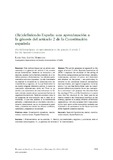Mostrar el registro sencillo del ítem
(Re)definiendo España: una aproximación a la génesis del artículo 2 de la Constitución española
| dc.creator | San Antón Moracho, Leire | es_ES |
| dc.date.accessioned | 2019-02-07T12:01:16Z | |
| dc.date.available | 2019-02-07T12:01:16Z | |
| dc.date.issued | 2018 | |
| dc.identifier.issn | 2341-0809 (Electronic) | |
| dc.identifier.uri | https://hdl.handle.net/2454/32152 | |
| dc.description.abstract | Este artículo busca ser un primer acercamiento a la génesis del artículo 2 de nuestra actual Constitución. Veremos su evolución y redacción, usando como fuentes, además de a notables juristas e historiadores, los debates parlamentarios así como la prensa. Lo más interesante es analizar la inclusión de la distinción entre nacionalidades y regiones, de la cual finalmente no se destila ninguna diferencia jurídica. A modo de conclusión esbozaremos cómo del Título viii se destila que carecemos de una estructura de Estado cerrada, donde caben numerosas formas de organización territorial. También veremos cómo la no adopción de una solución era lo ideal en el momento, lo que nos plantea si la Constitución pensada y elaborada en un momento concreto y debería considerarse, ya con la democracia asentada, y teniendo en cuenta los últimos conflictos, cambiarla y adaptarla a la realidad. | es_ES |
| dc.description.abstract | This article proposes an approach to the origins of article 2 of the Spanish Constitution of 1978. It explores the evolution of the writing of this article using sources parliamentary debates, contemporary opinions of jurists and historians and debates on the press. I am particularly interested in the distinction between nationalities (nacionalidades) and regions (regiones) made by article 2 to see that finally there were no constitutional differences between these two concepts. As a conclusion I will propose the idea that from the reading of Title viii of the Constitution it seems clear that the structure fo the State was by no means closed in the Constitution itself but, on the contrary, opened to a variety of forms of territorial organization. I will also propose that it was probably the best option at the moment but probably not intended to be permanent in the future evolution of the Spanish constitutionalism. | en |
| dc.format.extent | 28 p. | |
| dc.format.mimetype | application/pdf | en |
| dc.language.iso | spa | en |
| dc.publisher | Universidad Pública de Navarra / Nafarroako Unibertsitate Publikoa | es |
| dc.relation.ispartof | HUARTE DE SAN JUAN. Geografía e Historia N. 25 / Geografìa eta Historia 25.Z. Pamplona: Universidad Pública de Navarra / Nafarroako Unibertsitate Publikoa, 2018. Págs. 193-220 | es |
| dc.rights | Licencia Creative Commons Reconocimiento-NoComercial-SinObraDerivada 4.0 Internacional (CC BY-NC-ND 4.0) | es_ES |
| dc.rights.uri | https://creativecommons.org/licenses/by-nc-nd/4.0/ | |
| dc.subject | Constitución española | es_ES |
| dc.subject | Nación | es_ES |
| dc.subject | Debate constitucional | es_ES |
| dc.subject | España-Transición | es_ES |
| dc.subject | Spanish Constitution | en |
| dc.subject | Nation | en |
| dc.subject | Constitutional debate | en |
| dc.subject | Spain-Transition | en |
| dc.title | (Re)definiendo España: una aproximación a la génesis del artículo 2 de la Constitución española | es_ES |
| dc.title.alternative | (Re)defining Spain: an aproximation to the genesis of article 2 for the Spanish Constitution | en |
| dc.type | info:eu-repo/semantics/article | en |
| dc.type | Artículo / Artikulua | es |
| dc.rights.accessRights | info:eu-repo/semantics/openAccess | en |
| dc.rights.accessRights | Acceso abierto / Sarbide irekia | es |
| dc.type.version | info:eu-repo/semantics/publishedVersion | en |
| dc.type.version | Versión publicada / Argitaratu den bertsioa | es |



